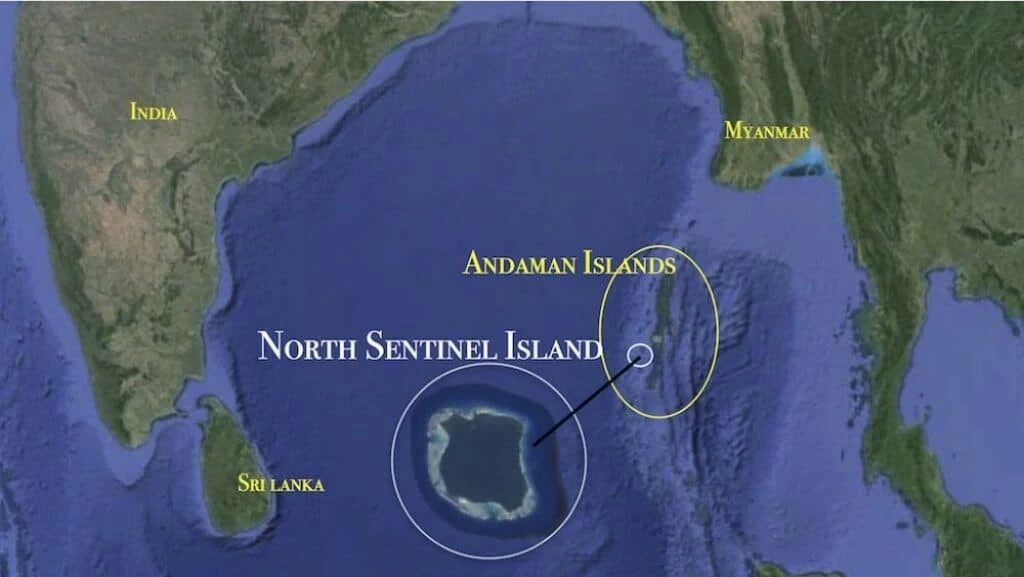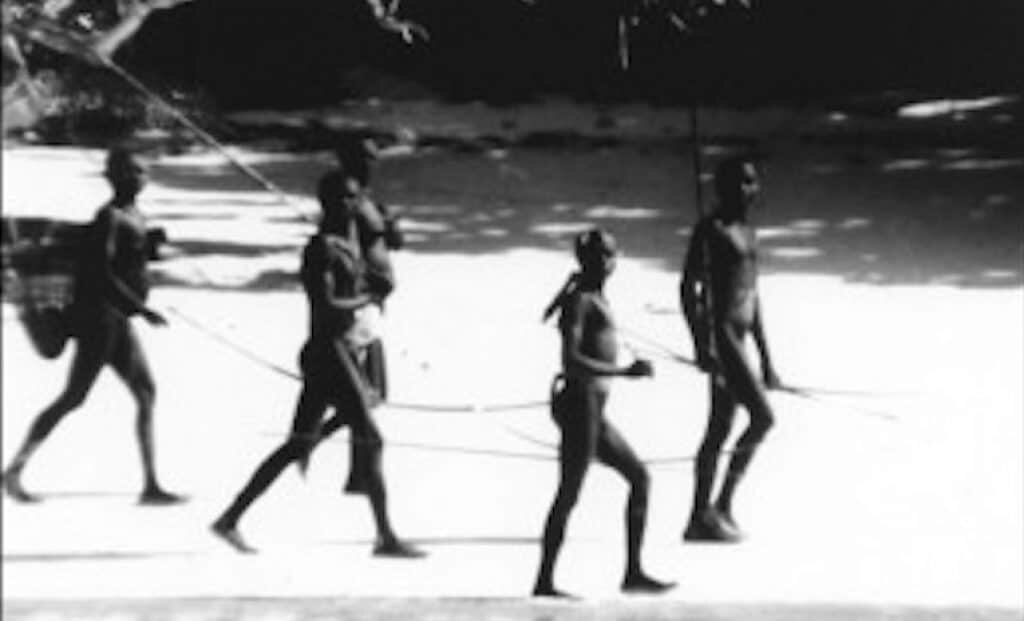Home to the pre-Neolithic tribe of Sentinelese, North Sentinel Island holds many mysteries.
North Sentinel Island is a small, remote island about 28 square miles nestled among the Andaman Islands southwest of Myanmar in the Bay of Bengal. The island falls under the dominion of the Indian government. They have banned all travel to the island because it is too dangerous to go there. As a result, we know very little about this place and its Sentinelese inhabitants. What we do know is that they are one of the oldest isolated cultures left in the world – a pre-Neolithic group. Essentially, they have not had any meaningful contact for up to 60,000 years. Where they came from and exactly when they got there are complete mysteries.
Researchers estimate the population of North Sentinel Island to be between fifty and a few hundred people. However, there is no way to be certain because no one can safely step foot on the island. It is difficult to imagine a place that is untouched by modern civilization. The Sentinel Island tribe defend themselves with bows and arrows, and they may kill anyone that gets too close. This is a place so dangerous it is commonly known as “The Forbidden Land.”

Who Are the North Sentinelese?
The Sentinelese are amongst a group of Andamanese tribes. Only three of five tribes that Europeans first documented in the Andaman islands still survive. The other two are now extinct. The three extant tribes are the Jarawa, the Onge, and the Sentinelese. The Andamanese are a very mysterious group of people because the results of genetic studies conflict widely. Additionally, researchers have not been able to get close enough to the North Sentinelese in order to collect DNA samples. Therefore, many presumptions about them have been extrapolated from other Andamanese populations.
Related: Easter Island History – From Settlement to Collapse
Because DNA results differ and there are conflicting theories about their migration, the true origin and relationship of the Andamanese people are murky.
What Does Genetic Work Tell Us?
Different Evolutionary Lineages
Genetic research in the early 2000s by Lalji Singh, director of India’s Centre for Cellular and Molecular Biology, showed that the Jarawa and Onge had genetic differences from each other that indicate either different migrations out of Africa or different origins altogether. He hypothesized that during the Ice Age, a land bridge connected Myanmar to the Andaman Islands. Migrations took place to the islands at some point when water levels were lower, but when the waters rose again, the islanders became isolated. “The Centre’s study has suggested that two ancient maternal lineages have evolved in the Andaman Islands in genetic isolation independently. This may be due to the initial penetration of the northern coastal areas of the Indian Ocean by modern humans in the migration out of Africa about 50,000 to 70,000 years ago” (Menon 2012).
Without DNA from the North Sentinelese, Dr. Singh was not able to conclusively determine whether or not they arrived at the same time as the rest of the Andamanese or if they were even the same group, but he did say, “The Sentinelese are the only pre-Neolithic tribe left in the world where no contact has been made” (Harding 2001).
A Possible Unknown Hominin
An interesting study was conducted recently by Mondal et al, and the results were published on June 25, 2016, in Nature Genetics. Their results show that the Andamanese (including the Sentinelese) people have an archaic human ancestor that has since gone extinct. Also, Asians and Pacific populations (including the Andamanese) appear to have migrated in one wave and expansion, contrary to the earlier theory of multiple waves out of Africa.
Related:
Scholars still debate when the Andamanese and Sentinelese arrived and also from where. Some DNA research suggests that they may have migrated from mainland India. Because they do not possess the genetic admixing that is seen when different populations of people come together, the group and their culture have presumably remained unchanged.
A Little Known Culture
As we would expect from an isolated ancient culture, the Sentinelese live a hunter-gatherer lifestyle. If they are like the other Andamanese, they eat monitor lizards, berries, pigs, and seafood that they catch in the surrounding reefs. They defend themselves with weapons such as handmade bows and arrows and spears. They’re capable of fishing in the nearby waters as far as they can paddle their rafts/canoes with their poles.
Their Need for Protection
The government of India has declared North Sentinel Island, including three miles extending outward, an exclusion zone. People are prohibited from going there. This law serves a number of purposes. By disallowing off-shore fishing, the food source of the islanders is protected. Eliminating contact with the Sentinelese also prevents the spread of fatal diseases to a population that has no immunity. Additionally, the law protects anyone attempting to visit the island, as the inhabitants defend themselves to the death. They do not allow anyone to step foot on the island. Lastly, the surrounding waters pose yet another risk; the seas tend to be very rough and coral reefs surround the island. Hence, many boats and ships have run aground on the rocks. Some of the marooned individuals were rescued by their governments, but others were killed or injured by the islanders.
Early Interactions
Although there is no proof that the Sentinelese are, or ever were, cannibals, they have certainly left an impression on anyone who has seen them. Perhaps it was their fearsome displays that led Marco Polo, the famous explorer who traveled through Asia, to say of the Andamanese, “But they are a most cruel generation, and eat everybody that they can catch, if not of their own race.”
The earliest record of any interaction with the islanders is from 1771 when John Ritchie, a British surveyor, saw “a multitude of lights” while sailing past the island during a survey trip. In 1867, an Indian merchant ship called the “Ninevah,” wrecked on a nearby reef. The tribe attacked them, but the crew was able to fend off the attacks until the Royal Navy finally rescued them.
The Capture of North Sentinelese
In the late 1800s, British explorer Maurice Vidal Portman made several expeditions to North Sentinel Island. He sought to learn more about the island for the British empire. Once they landed safely on the island, they decided to explore. The team discovered some trails and deserted villages. Eventually, they found and captured six islanders and took them back to Port Blair, South Andaman Island, to learn more about them. After a short time, the prisoners became sick and two of them died. This resulted because they did not have the immunities to fight off common infections of the modern world. The British took the remaining captives back to the island and released them back to their people with bundles of gifts.
Self-Preservation
Many ships capsized in the reefs over the years. Some men survived, while others died. Most recently in 2006, a report emerged of two sailors who disregarded the exclusion zone and decided to fish close to the island overnight. But when they woke up, they had drifted much too close to the island. Unfortunately, the islanders murdered the fishermen and buried them in the sand.
There is documentation suggesting that visitors who wander onto the island face serious consequences. The North Sentinelese put on fierce demonstrations by gesturing and throwing spears and arrows if a ship or helicopter gets too close. However, if it were not for their self-protective behaviors, perhaps they too would have gone extinct like other tribes of the Andaman Islands.

This forbidden land is protected by the government, its people, and also by the environment around it. In time, we will see if the Sentinelese will be able to fend off the problems that led to extinction for its Andamanese neighbors. They must remain isolated or, chances are, they will perish.
*Last updated by HM staff 3/28/17.
References:
“The Sentinelese People”
The Forbidden Island
NCBI